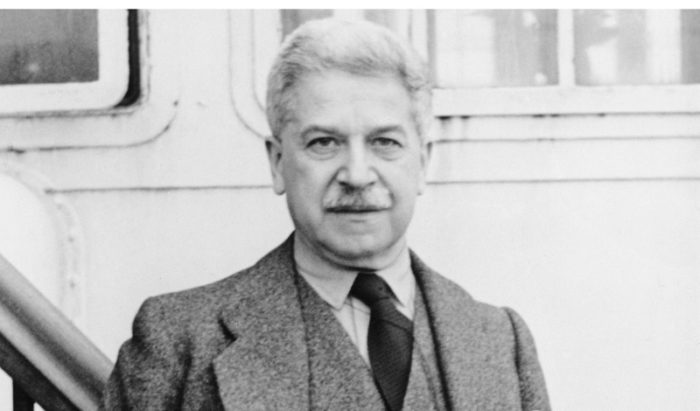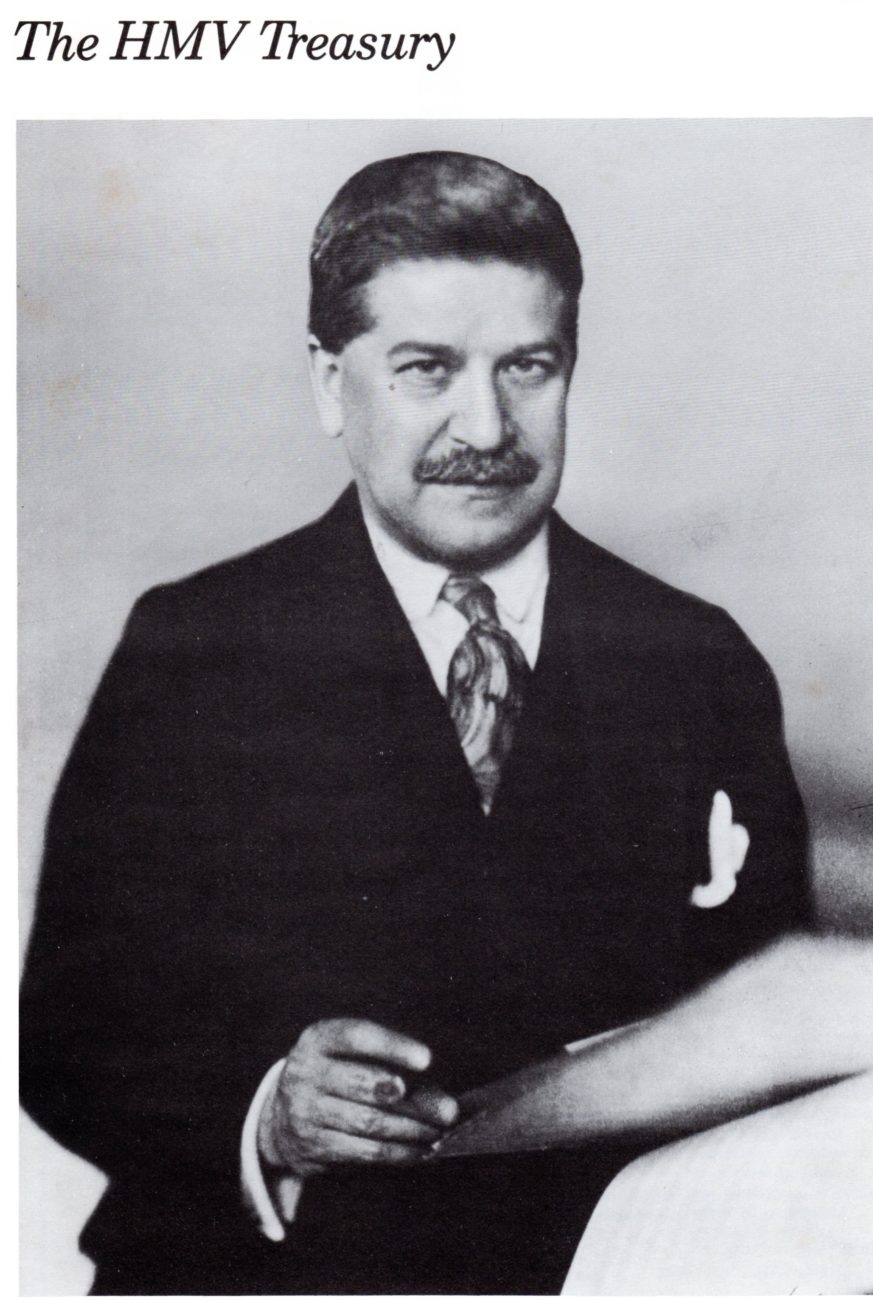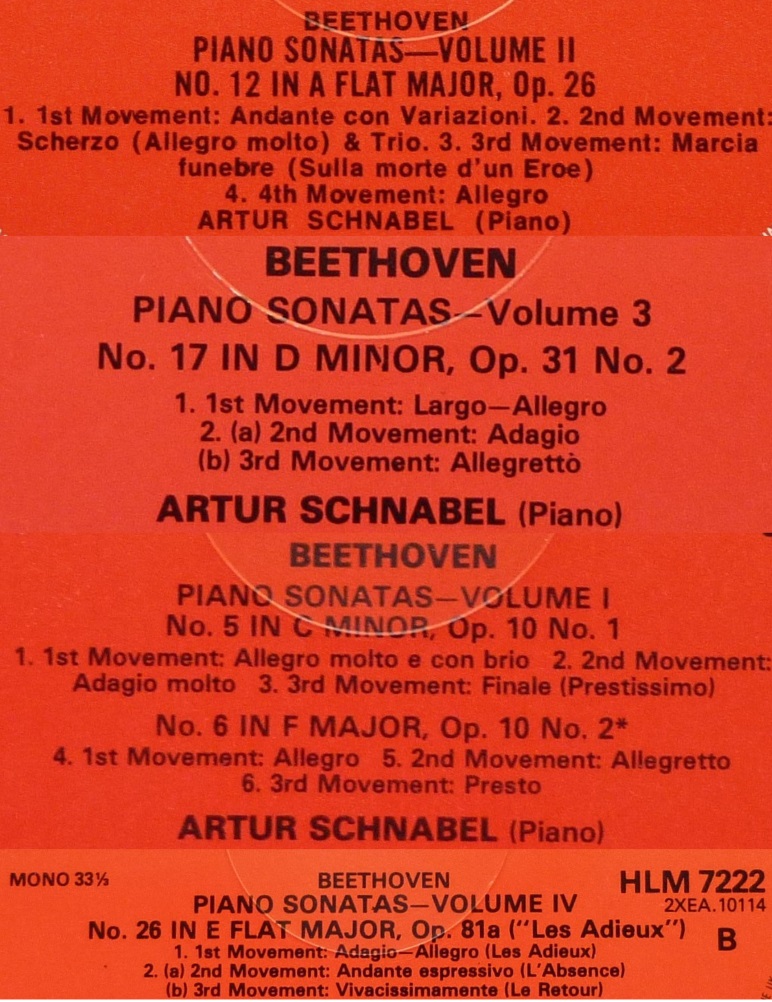
Schnabel – Beethoven Sonates – IV/VII – Sonates n°12 Op.26 – n°17 Op.31 n°2 – n°5 Op.10 n°1 – n°6 Op.10 n°2 – n°26 Op.81a
Sonate n°12 Op.26: 25-27 Avril & 4 Mai 1934
Sonate n°17 Op31 n°2: 27& 28 Avril 1934
Sonate n°5 Op.10 n°1: 6 Novembre 1935
Sonate n°6 Op.10 n°2: 10 Avril 1933
Sonate n°26 Op.81a: 13 Avril 1933
Artur Schnabel, piano
London Abbey Road Studio n°3 – Engineer: Edward Fowler – piano: Bechstein
Source: disques 33 tours « The HMV Treasury »
Le quatrième programme de l’intégrale des 32 sonates de Beethoven par Artur Schnabel comportait les cinq sonates mentionnées ci-dessus, dont les deux premières ont été jouées en première partie de concert.
Pour plus de détails sur les sept récitals de cette intégrale, cliquer ICI

Pour le quatrième programme de l’intégrale donnée par Schnabel à Carnegie Hall en 1936, Olin Downes souligne tout d’abord que le plus grand mérite de Schnabel est de démontrer une fois pour toutes au public de cette ville l’immense variété de contenu qui se trouve dans tout groupe de quatre ou cinq sonates de Beethoven, d’autant plus qu’il a la sagesse de les jouer, non par ordre chronologique, mais d’opposer des sonates de ‘styles’ et d »époques’ différentes d’une manière à la fois évocatrice et divertissante. » C’était également le cas hier soir, bien que Schnabel ait été d’humeur inégale. Dans la sonate en la mineur op.26 (n°12) qui ouvrait le programme avec un mouvement en variations, l’énoncé du thème était exagéré quant au style, le son était dur et l’interprétation était didactique et autoritaire. La sonate était au-delà du tempérament de l’exécutant, sans qu’on puisse du tout en déduire que Mr. Schnabel, en dépit de son objectivité et de son analyse, soit un interprète purement objectif. C’est même tout le contraire! Et il l’a prouvé dans l’interprétation suivante, celle de la sonate en ré mineur (n°17 Op.31 n°2) au dramatisme orageux, qui dans l’ensemble était la plus grande réussite de la soirée. Dans le premier mouvement qui pourrait bien porter comme spécifié pour d’autres sonates du compositeur, le sous-titre ‘quasi una fantasia’, il y avait du drame , presque du théâtre, sous sa forme la plus passionnée. Le chant dans l’Adagio, mouvement noblement proportionné, aurait pu être plus simple. Le Finale était puissamment conduit avec un sentiment romantique, et Mr. Schnabel a clairement montré que si ses motifs sont ostensiblement banaux, son expression est intense et agitée. Il s’est ensuite consacré à l’humour et à l’imagination de la sonate en do mineur Op.10 n°1 (n°5) ainsi qu’à une autre sonate, virile et joyeuse et elle aussi d’une veine plus légère, celle en fa majeur Op.10 n°2 (n°6) avec un ‘Scherzo’ (Allegretto) qui rappelle les hésitations du mouvement correspondant de la Cinquième Symphonie et son merveilleux trio. Les deux premiers mouvements, en particulier le deuxième étaient beethovéniens jusqu’à l’âme et si sans doute le Finale doit être très rapide, cela ne doit pas interférer avec la clarté comme cela a été le cas hier soir, où la clarté qui est une des vertus cardinales de Mr. Schnabel n’était pas toujours présente. Pour finir, c’était la sonate « Les Adieux » (n°26 Op.81a), « romantique » quant à son expression, mais dans une certaine mesure prophétique de développements modernes de la musique, et à cause de cela surestimée par ceux pour qui Beethoven ne saurait se tromper. Mais ici Mr. Schnabel est allé loin dans la révélation de la plénitude de la pensée de Beethoven, là où l’intuition ainsi qu’une profonde connaissance sont requises de l’exécutant. Le public a écouté avec dévotion et a tout applaudi frénétiquement ».
Le lendemain de ce concert, commençait au Metropolitan Opera le Cycle Wagner (6 février – 5 mars) donné chaque année avec le Ring et les Meistersinger dirigé par Artur Bodanzky et une distribution de rêve.

The fourth program of the complete performance of Beethoven’s 32 sonatas by Artur Schnabel was comprised of the five above mentioned sonatas, two of which being played before the intermission.
For a detailed description of the seven programs of his complete performances of Beethoven’s 32 sonatas, click HERE

For the fourth program of the complete performance given by Schnabel at Carnegie Hall in 1936, Olin Downes points out that, had Mr. Schnabel accomplished nothing else for the benefit of the public of this city, he would have demonstrated once and for all the immense variety of matter and of mood that any four or five of the thirty-two Beethoven sonatas contain. » He has had the wisdom, in program-making not to play these works in their historic sequence, but to contrast sonatas of different ‘periods’ and ‘styles’ in a way that is highly suggestive and entertaining… This was realized anew last night although Mr. Schnabel appeared to be in an uneven mood. He began with the A-flat sonata Op. 26 (n°12) which opens with variations. The announcement of the theme was exaggerated in style; tone most of the time was hard; there was a didactic and overbearing manner of interpretation.. The sonata apparently was outside the performer’s mood, and let no one think that Mr. Schnabel, for all his objectivity and analysis, is a purely objective player. Quite the contrary! He proved this in the performance that followed, which on the whole was the finest achievement of the evening. The sonata was the one in D minor (n°17 Op.31 n°2), stormily dramatic, a sonata which, like others so specified by the composer, could well bear the title in the first movement of ‘quasi una fantasia’. This was drama, almost theatre, of the most impassioned sort. The Adagio, nobly proportioned, could have been sung more simply. The Finale was given a powerful drive and again, dramatic feeling. Ostensibly trivial in its motives, it is actually a very expressive and agitated utterance, as Mr. Schnabel made clear. He turned then to the humor and fancy of the C minor sonata (n°5 Op.10 n°1) and to another sonata, virile, jocose, also in a prevailingly lighter vein, the one in F major Op.10 n°2 (n°6) with the ‘Scherzo’ (Allegretto) remindful of the gropings of the corresponding movement in the Fifth symphony, and the wonderful trio. The first two movements, especially the second, were Beethoven to the core. No doubt the finale should go very fast, but not so fast as to interfere with clearness, which was the case last night, when clearness, one of the cardinal attributes of Mr. Schnabel’s playing was not invariably in evidence. The end came with ‘Les Adieux’ sonata (n°26 Op.81a), ‘romantic’ in expression, prophetic in certain measures of modern musical developements, for all that a sonata overrated by those for whom Beethoven can do no wrong. But here, Mr. Schnabel went far to reveal the completeness of Beethoven’s meaning, in measures where divination as well as profound knowledge on the part of the performer is required. The audience listened devoutly. Everything that was done was rapturously applauded. »
The day after this concert, the annual matinee Wagner Cycle (February 6 – March 5) conducted by Artur Bodanzky began at the Metropolitan Opera with the Ring and Die Meistersinger and a dream cast.





5 réponses sur « Schnabel – Beethoven Sonates – IV/VII – Sonates n°12 Op.26 – n°17 Op.31 n°2 – n°5 Op.10 n°1 – n°6 Op.10 n°2 – n°26 Op.81a »
HD/Hi-Res (24 bits/88 KHz):
https://e.pcloud.link/publink/show?code=kZleOHZEYfe2tjmDHSlupbUou7inps12tTX
Format CD (16 bits/44 KHz):
https://e.pcloud.link/publink/show?code=kZqeOHZSpINlXa8Ih0FDMMFwPzXUptWeyey
Great series, thank You.
Thank you once again for sharing this series for the ages in the best-sounding transfers possible!
Schnabel took great care in making recordings that were faithful to his playing especially as to nuances and dynamics.
It is just a pity that the commercial issues with the notable exception of Pearl mostly ignore this just to make the sound comfortable by removing background noise.
Such transfers are often a travesty of his playing which is at times rendered ununderstandable and sometimes even ridiculous, hence the negative comments by the critics who rely on what they hear on these commercial CDs.
This kind of restoration would be unacceptable for paintings!
Thank you so much for sharing these transfers. You are doing a great service to this wonderful artist, and we music lovers are deeply indebted to you.
Now I have ordered all the HMV LPs. Hopefully they will be a definitive rendering in my collection